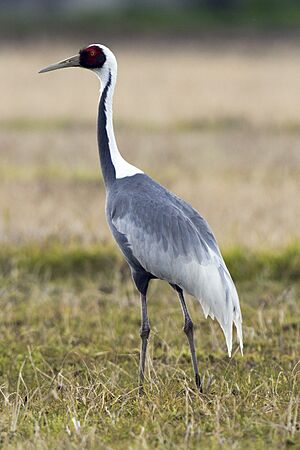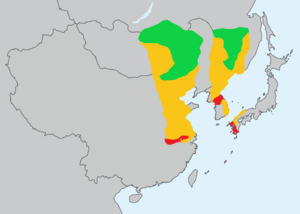White-naped crane facts for kids
Quick facts for kids White-naped crane |
|
|---|---|
 |
|
| White-naped crane at Saijo, Ehime, Japan | |
| Conservation status | |
| Scientific classification | |
| Genus: |
Antigone
|
| Species: |
vipio
|
 |
|
| Geographical distribution. Green: Breeding |
|
The white-naped crane (Antigone vipio) is a beautiful and large bird that belongs to the crane family. These elegant birds can grow to be about 112 to 125 centimeters (44 to 49 inches) long. They stand around 130 centimeters (4.3 feet) tall and weigh about 5.6 kilograms (12.3 pounds). You can easily spot them by their pinkish legs, a neck with cool grey and white stripes, and a bright red patch on their face.
Contents
Where White-Naped Cranes Live
White-naped cranes live in parts of Asia. They breed, which means they lay their eggs and raise their young, in northeastern Mongolia, northeastern China, and nearby areas of southeastern Russia. There's even a special program in Russia at the Khingan Nature Reserve. This program helps to raise eggs from U.S. zoos to help more cranes survive in the wild.
Crane Migration and Winter Homes
When winter comes, these cranes fly long distances to warmer places. Different groups travel to areas near the Yangtze River in China. Others go to the Korean Demilitarized Zone or to Kyūshū in Japan. You might also find them in Kazakhstan and Taiwan. Sadly, there are only about 4,900 to 5,400 white-naped cranes left in the wild.
What White-Naped Cranes Eat
White-naped cranes are not picky eaters! Their diet mainly includes insects, seeds, and roots. They also enjoy eating different kinds of plants and small animals they find.
Protecting White-Naped Cranes
The white-naped crane is considered a vulnerable species. This means they are at risk of becoming endangered if we don't protect them. Their numbers are decreasing because they are losing their natural homes. Also, in some areas, too many cranes are hunted.
Conservation Efforts
Because they are vulnerable, the white-naped crane is listed on the IUCN Red List of Threatened Species. It is also protected by CITES, which is an international agreement. CITES helps control the trade of animals and plants to make sure they don't disappear. In South Korea, the white-naped crane is so important that it has been named Natural Monument 203.
How Cranes Are Classified
For a long time, the white-naped crane was placed in a group called Grus. But scientists studied their DNA and found that this group needed to be reorganized. So, in 2010, the white-naped crane and three other species were moved. They now belong to a different group called Antigone. This group was first named by a German scientist, Ludwig Reichenbach, way back in 1853.
Gallery
-
A mated pair performing a "unison call", which strengthens the pair bond and provides a territorial warning to other cranes.






